by Peter Wagner,
June 18, 2016
I recently had the opportunity to screen a new documentary, Off the Rails that tells the story of Darius McCollum:
“a man with Asperger’s syndrome whose overwhelming love of transit has landed him in jail 32 times for impersonating New York City bus drivers and subway conductors and driving their routes.”
As a boy in Queens, NY, Darius found sanctuary from school bullies in the subway. There he befriended transit workers who taught him to drive trains. By age 8, he memorized the entire subway system. At 15, he drove a packed train 8 stops by himself, making all the stops and announcements.
Over the next three decades, Darius commandeered hundreds of trains and buses, staying en route and on schedule, without ever getting paid. He attended transit worker union meetings, lobbying for better pay and working conditions for a union he didn’t belong to.
Although Darius has never damaged any property or hurt anyone in his decades of service, he has spent 23 years in maximum security prison. Darius’ recidivism embodies the criminal justice system’s failure to channel the passions of a harmless, mentally challenged man into a productive career and purposeful life.
The film demonstrates, through this unique and well-told story, that when confronting people with disabilities, the criminal justice system all too often has a one-track mind.
This is the trailer:
Upcoming screenings are in Provincetown, MA (June 19), Red Bank, NJ (July 7), Toronto Canada (July 20), Woods Hole, MA (August 1) with dates in New York to be added this fall.
An increasing number of fathers are spending Father's Day behind bars, away from their loved ones.
by Alison Walsh,
June 17, 2016
Father’s Day is stereotypically a happy occasion. But an increasing number of fathers will spend the day away from their loved ones, separated by prison walls. The number of incarcerated men who reported being the fathers of minor children rose to nearly 750,000 in 2007 (the most recent year for which we have data available), a 57% increase from 1991. This holiday is a reminder that incarceration affects entire families, not just the people behind bars.
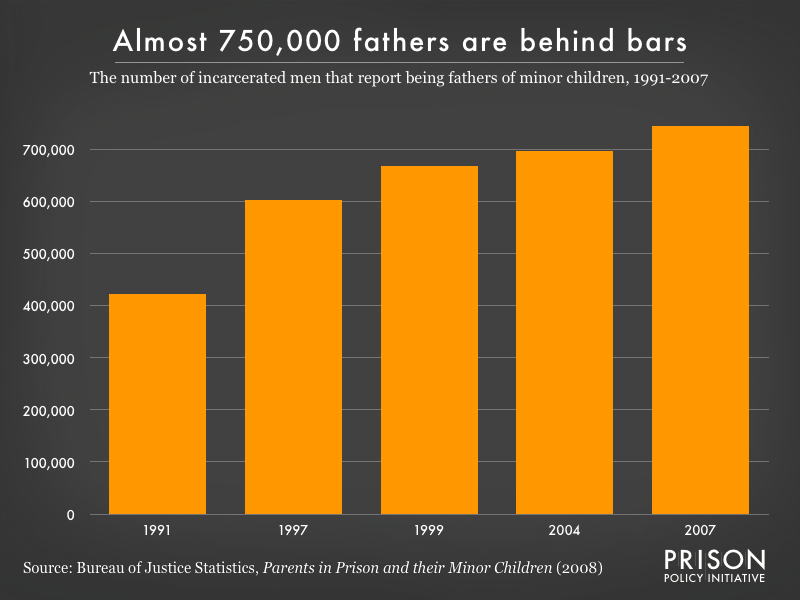
Prison Policy Initiative's new report, "States of Incarceration: The Global Context 2016," compares the incarceration rates of individual U.S. states to that of other countries.
June 16, 2016
FOR IMMEDIATE RELEASE: June 16, 2016
Contact:
Alison Walsh
awalsh [at] prisonpolicy.org
Easthampton, MA — How does your state compare to the international community when it comes to the use of incarceration? Not very well, says a new report and infographic by the Prison Policy Initiative.
“When compared against each other, some U.S. states appear to be far more restrained in their use of incarceration than high incarcerators like Louisiana,” said Peter Wagner, Executive Director of the Prison Policy Initiative and co-author of the report. “But all U.S. states are out of step with the rest of the world.”
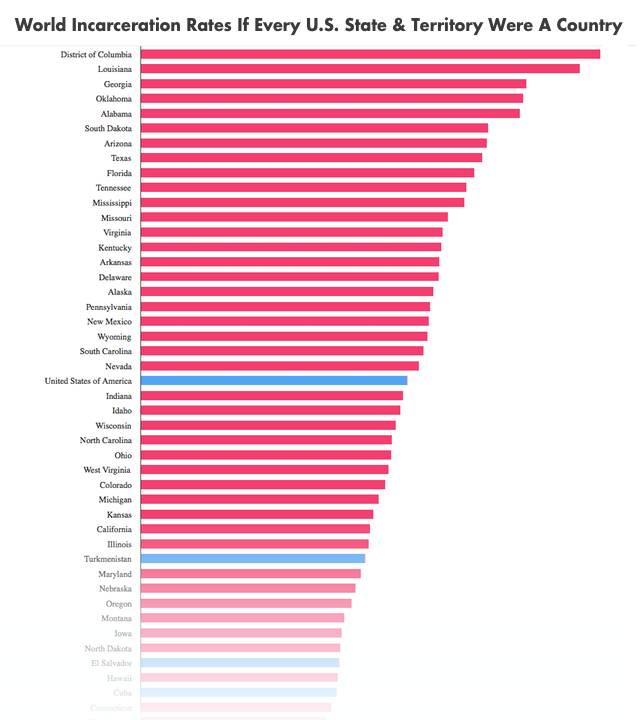
This report, “States of Incarceration: The Global Context 2016,” updates our 2014 briefing that, for the first time, directly situated individual U.S. states in the global context.
“Massachusetts and Vermont have the lowest incarceration rates in the U.S.,” said Alison Walsh, report co-author and Policy & Communications Associate. “Compared to Louisiana, these states look progressive. But if these states were independent nations, they would rank as the 11th and 12th greatest users of incarceration on the planet, following the United States and a group of nations whose recent history often includes wars, military coups and genocides.”
The report includes an interactive graphic showing the incarceration rates for individual U.S. states and the District of Columbia and all countries with a population of at least 500,000. The report also includes a separate graphic comparing the incarceration rates of the U.S. to several NATO nations.
“I hope that this data helps all states prioritize further criminal justice reforms. Lower incarceration rates are not only possible, in the rest of the world they are a reality,” said Wagner.
The report and infographic draw international figures on incarceration from the Institute for Criminal Policy Research’s World Prison Brief and state-level figures from the Bureau of Justice Statistics, the Bureau of Prisons and the U.S. Census Bureau.
The Easthampton, Massachusetts-based Prison Policy Initiative was founded in 2001 to expose the broader harm of mass criminalization and spark advocacy campaigns to create a more just society. The organization is most well known for sparking the movement to end prison gerrymandering and for its big picture data visualization “Mass Incarceration: The Whole Pie.”
The report, “States of Incarceration: The Global Context 2016,” is available at:
http://www.prisonpolicy.org/global/2016.html
Ohio follows in Massachusetts' footsteps by ending unnecessary driver's license suspensions.
by Alison Walsh,
June 15, 2016
In Ohio this week, Governor John Kasich signed a bill into law that allows judges to choose whether to suspend driver’s licenses for non-driving related drug offenses. Prior to this reform, these suspensions were mandatory.
The bill’s sponsor, Senator Bill Seitz, argued that the suspension policy created an unnecessary barrier to employment. The governor of Massachusetts cited similar concerns when he ended automatic license suspensions for drug offenses unrelated to road safety in March.
Several states, including Texas and New York, still enforce this outdated law, but momentum is on the side of reform. In Seitz’s words, “We’re not doing anything radical — we’re kind of catching up to the crowd.” Which state will be next?
Stay tuned for a Prison Policy Initiative report on the remaining states that have yet to repeal this regressive law.
Private prisons get all the attention, but the hidden truth is that many county jails are profiting off incarceration too.
by Peter Wagner,
June 9, 2016
Prisons owned and run by corporations that contract with state governments get far more attention than they deserve. But another huge provider of contractual prison services gets almost no attention whatsoever: local jails.
Yes, local jails. Nationally in 2014, 5.2% of those sentenced to prison were placed in county jails under contracts between state prison officials and local jails (compared to 8.4% with private prisons). In some states, this is big business for jails. In 2014, a whopping 51% of Louisiana’s state prison population was imprisoned in local jails. Or to say it another way, 75% of the jail cells in Louisiana parish (county) jails are used not for people serving jail sentences but are instead rented out to the state. And Louisiana isn’t alone:
| State |
Percent of jail beds rented to state/federal prisons |
| Louisiana |
75.5% |
| Mississippi |
55.1% |
| Kentucky |
45.6% |
| Arkansas |
41.3% |
| Tennessee |
30.8% |
| Oklahoma |
25.5% |
| Utah |
25.2% |
| Virginia |
25.1% |
| West Virginia |
25.0% |
| Texas |
19.5% |
| Idaho |
18.7% |
| Montana |
17.8% |
| Alabama |
15.7% |
| Minnesota |
14.5% |
| Georgia |
12.8% |
In 15 states, over 10% of the local jail population was made up of people serving state or federal prison sentences in 2013. In 9 states, it was at or over a quarter of the jail population, in Mississippi it was over half, and in Louisiana the number was over 75%. Nationwide, 12% of the local jail population is actually there under contract with state or federal authorities. These figures were calculated from two Bureau of Justice Statistics data sources, the Mortality in Local Jails and State Prisons Series and National Prisoners Statistics Series.
The profit motive produces alarming effects. Local sheriffs rely heavily on state money to pad their law enforcement budgets and, as a result, have no incentive to support reforms to reduce the incarcerated population. In fact, the opposite is often true.
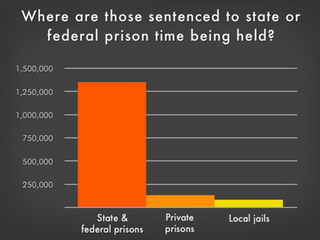 In Louisiana, sheriffs and wardens trade incarcerated people from parish to parish in an attempt to keep their jail beds full and the state money rolling in. It’s common for jail wardens to “make daily rounds of calls” to other parishes looking for incarcerated people to fill their beds when their jails are under-capacity. One Louisiana parish warden told The Times-Picayune, “I stay on the phone a lot, calling all over the state, trying to hustle a few.” Hustle a few incarcerated people, that is.
In Louisiana, sheriffs and wardens trade incarcerated people from parish to parish in an attempt to keep their jail beds full and the state money rolling in. It’s common for jail wardens to “make daily rounds of calls” to other parishes looking for incarcerated people to fill their beds when their jails are under-capacity. One Louisiana parish warden told The Times-Picayune, “I stay on the phone a lot, calling all over the state, trying to hustle a few.” Hustle a few incarcerated people, that is.
In Oklahoma, local sheriffs receive $27 per day for each person they hold for the state prison system, this makes up about 7% of some counties’ budgets. Sheriffs have gotten so dependent on the money from the state that they complained to the press when the prison system implemented reforms to reduce the state prison population.
And in Mississippi, in addition to the $29.74 per diem, the state “demands that local jails house state convicts who perform labor for free”. In some cases, incarcerated people perform city services, like picking up residents’ garbage. The Mississippi sheriffs see corporate private prisons as their direct competitors for a share of the declining number of people sentenced to state custody. The president of one county’s Board of Supervisors told the Huffington Post, “I think it’s political favors going around, the reason they’re doing that”, referring to his suspicion that state contracts were being given to private corporations rather than local jails.
In the end, the real harm is being done to those incarcerated. Local jails with profit motives are incentivized to house increasing numbers of people, without regard for services or educational programs for those incarcerated. The Times-Picayune reports that in Louisiana, those stuck in local jails on state contracts “subsist in bare-bones conditions with few programs to give them a better shot at becoming productive citizens.”
Incarcerated people find themselves locked in local jails for months, or even up to 10 years in Louisiana, unable to get access to the programs and services that may help them successfully reenter society. For this reason The Times-Picayune says, “Ask anyone who has done time in Louisiana whether he or she would rather be in a state-run prison or a local sheriff-run prison. The answer is invariably state prison.”
It is time to accept the counter-intuitive truth: sometimes the government profits off of mass incarceration.
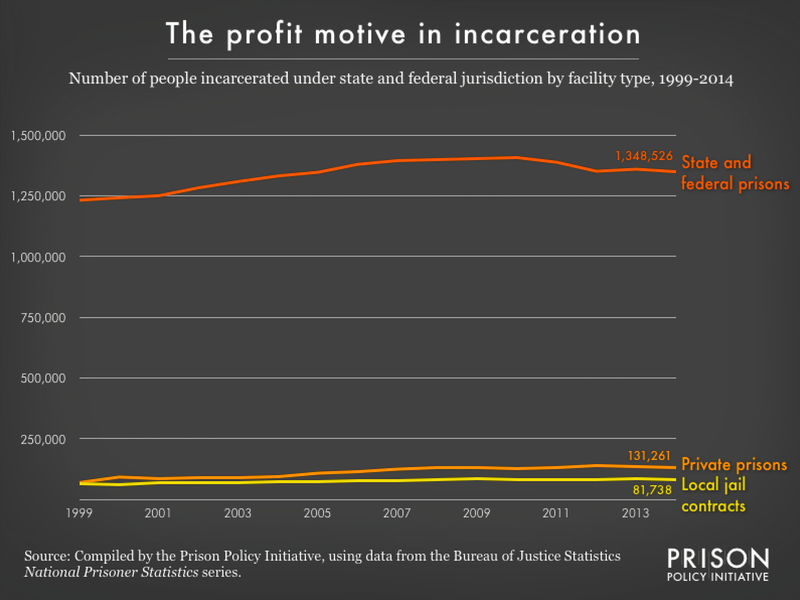 Since 1999, private prisons and local jails have housed roughly the same number of those serving state and federal prison sentences. But when those interested in justice reform talk about profiting off of mass incarceration, they almost always leave local jails out of the conversation.
Since 1999, private prisons and local jails have housed roughly the same number of those serving state and federal prison sentences. But when those interested in justice reform talk about profiting off of mass incarceration, they almost always leave local jails out of the conversation.
A report by the EFF uncovers some alarming facts about a new "Tattoo Recognition Technology" research program that uses images obtained from incarcerated people.
by Alison Walsh,
June 7, 2016
An investigation by the Electronic Frontier Foundation has discovered that government scientists with the National Institute of Standards and Technology (NIST) are working with the FBI to develop automated “Tattoo Recognition Technology” for future use by police. Not only does this technology raise important civil liberties concerns, the Electronic Frontier Foundation (EFF) is objecting to how the data for this research was collected: from incarcerated people without their consent.
The digit rights advocacy group points out in a new report that NIST project leaders only submitted their research for ethical review after the experiments had concluded.
NIST’s Tattoo Recognition Technology program also raises serious questions for privacy: 15,000 images of tattoos obtained from arrestees and inmates were handed over to third parties, including private companies, with little restriction on how the images may be used or shared. Many of the images reviewed by EFF contained personally identifying information, including people’s names, faces, and birth dates.
If that wasn’t alarming enough, NIST researchers also failed to follow protocol for ethical research involving humans—they only sought permission from supervisors after the first major set of experiments were completed. These same researchers have also not disclosed to their supervisors that the tattoo datasets they are using to seed the experiments came from prisoners and arrestees. Under federal research guidelines, research involving prisoners triggers enhanced scrutiny and ethical oversight to prevent their exploitation. Instead, NIST and the FBI are treating inmates as an endless supply of free data. The EFF found that the Tattoo Recognition Technology research program violates existing federal ethics rules on experiments involving incarcerated people.
The lack of oversight is alarming, especially because there is a disturbing history of vulnerable populations being used for unsanctioned experiments that cause them harm. Past ethical abuses, like the infamous Tuskegee syphilis experiments on African-American men in the South and the brutal tests performed on men incarcerated at the Holmesburg Prison in Philadelphia, led to new rules to protect vulnerable populations from abuse. Research using incarcerated people now must be pre-approved by an Independent Review Board. That review didn’t happen here.
The EFF is calling on the government to immediately suspend the program, and for scientists to stop using images obtained from incarcerated people without their consent. This demand is particularly timely as the FBI and the NIST are about to launch the next stage of their research, which will involve the distribution of over 100,000 images.
Add your voice to the EFF’s campaign by visiting their Action Center and sending a message to the NIST that scientific ethics and human rights matter.
New report provides big picture of mass incarceration with pie charts for each state and D.C.
June 1, 2016
FOR IMMEDIATE RELEASE: June 1, 2016
Contact:
Bernadette Rabuy
brabuy [at] prisonpolicy.org
Easthampton, MA — Prisons are just one piece of the correctional pie. Some of the seemingly less punitive states are actually the most likely to put their residents under some other form of correctional control, finds a new report by the Prison Policy Initiative.
Correctional Control: Incarceration and supervision by state builds off of the Prison Policy Initiative’s popular report, Mass Incarceration: The Whole Pie, to provide the big picture of mass incarceration. “We often get requests for versions of the pie chart report for each state. Our new report responds to this request with over 100 graphs illustrating the breakdown of the criminal justice system in each state plus D.C.,” said co-author of the report, Peter Wagner. The report also includes an interactive chart that ranks each state and D.C. by rate of total correctional control, which includes incarceration, probation, and parole.
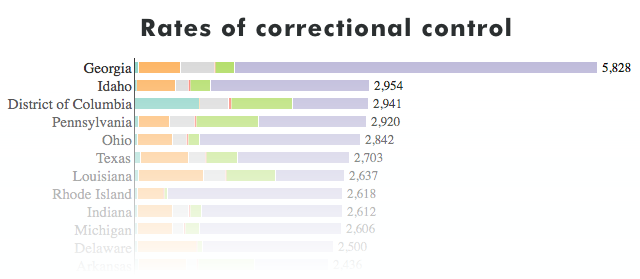
The report uncovers tremendous variations in the forms and rates of criminal justice control:
- Georgia’s rate of probation is more than double every other states’ rate of probation and greater than every other states’ total rates of correctional control.
- Rhode Island and Minnesota, two states with some of the lowest incarceration rates in the country, are among the most punitive when other methods of correctional control are taken into account.
- The capital of the “free world,” D.C., has a higher incarceration rate than any U.S. state and higher than any nation on the planet.
Correctional Control provides another metric for understanding where each state falls within the national landscape of mass incarceration and where state-based advocates may want to focus their attention. The authors of Correctional Control conclude that criminal justice reform strategies should aim to reduce the total number of people under correctional control rather than simply transfer people to other pieces of the correctional pie.
“As the movement to end mass incarceration continues to gain steam, it would be wise to include probation, the leading type of correctional control, in discussions of reform,” explained co-author of the report, Bernadette Rabuy. “Probation has the potential to be a powerful alternative to incarceration but, when used unnecessarily, serves only to widen the net and funnel more people into incarceration.”
The report and the 100+ graphs are available at: http://www.prisonpolicy.org/reports/50statepie.html
-30-


 In Louisiana, sheriffs and wardens trade incarcerated people from parish to parish in an attempt to keep their jail beds full and the state money rolling in. It’s common for jail wardens to “
In Louisiana, sheriffs and wardens trade incarcerated people from parish to parish in an attempt to keep their jail beds full and the state money rolling in. It’s common for jail wardens to “ Since 1999, private prisons and local jails have housed roughly the same number of those serving state and federal prison sentences. But when those interested in justice reform talk about profiting off of mass incarceration, they almost always leave local jails out of the conversation.
Since 1999, private prisons and local jails have housed roughly the same number of those serving state and federal prison sentences. But when those interested in justice reform talk about profiting off of mass incarceration, they almost always leave local jails out of the conversation.



